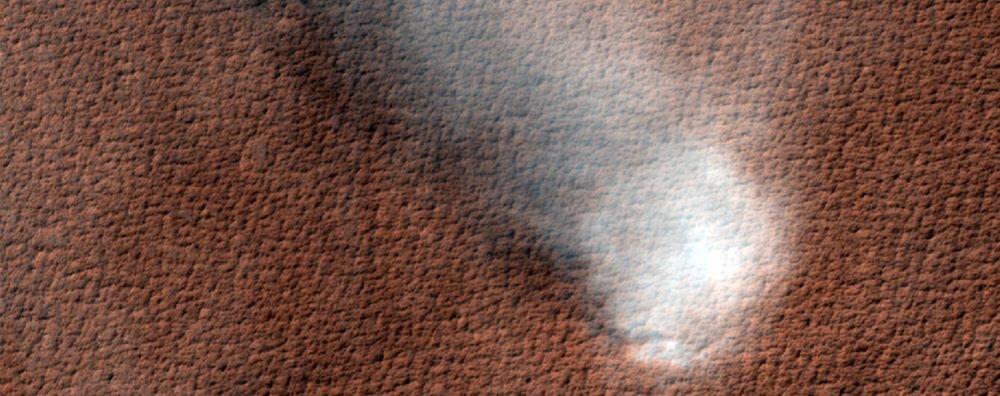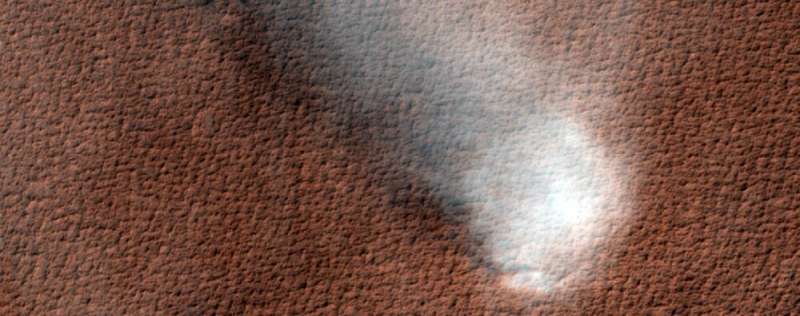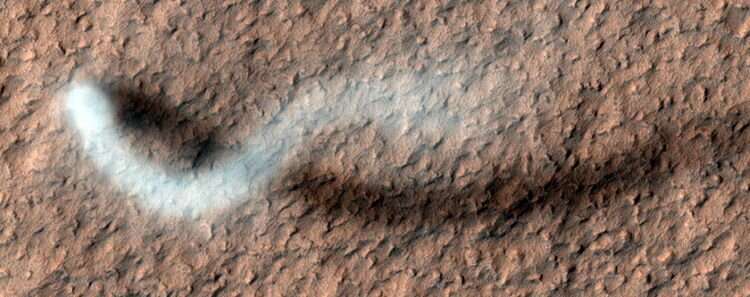

NASA recently used its powerful High Resolution Imaging Experiment (HiRISE) camera onboard the Mars Reconnaissance Orbiter to take a breathtaking image of a dust devil traversing Syria Planum on Mars. One unique aspect of dust devils is their shadows can be used to estimate their height, which have been estimated to reach 20 km (12 miles) into the Martian sky.
Studying dust devils on Mars is a regular occurrence for the scientific community and can help scientists better understand surface processes on other planets. But with the atmospheric pressure on Mars being only a fraction of Earth’s, what processes are responsible for producing dust devils?
“We think it’s similar to the Earth,” Dr. Shane Byrne, an associate professor and assistant department head at the Lunar and Planetary Laboratory at the University of Arizona and a deputy principal investigator on HiRISE, tells Universe Today.
“Dust devils are basically solar powered. The ground heats up so air starts to rise in columns. If the column is spinning, then it can get narrower and spin faster. As long as hot air is available at the bottom then the dust devil can survive. If the dust devil stops moving or moves over colder ground, then it dissipates. Dusty regions on Mars can have very hot surfaces during the day so they’re good areas to form dust devils.”
As stated, scientists study dust devils on Mars regularly, and Syria Planum isn’t the only place on the Red Planet where HiRISE has observed them. Other locations include Amazonis Planitia, southern latitude dune fields, Ganges Chasma (Valles Marineris), and Nili Fossae. Martian dust devils can not only reach several kilometers into the sky, but they are also known for leaving tracks and streaks across the Martians surface, as observed in Nili Fossae.
These tracks not only help scientists learn more about dust devils, but dust storms on Mars, as well. This is because dust storms erase old dust devil tracks, allowing new ones to be created, which allows scientists to monitor activity from both processes.
“Dust devils are important because they contribute to the baseline level of dust in the Martian atmosphere, which is an important driver of weather and atmospheric heating,” Dr. Colin Dundas, a research geologist at the U.S. Geological Survey Astrogeology Science Center and a co-investigator on HiRISE, tells Universe Today. “They also modify the surface and can clean dust off of the solar panels of spacecraft such as the Mars Exploration Rovers.”
This cleaning of solar panels became prevalent during both the Spirit and Opportunity (Oppy) rover missions, which were each initially designed to last only 90 sols (92.5 Earth days) but ended up lasting 2,695 Earth days and 5,498 Earth days, respectively. Along with sturdy engineering, both Spirit and Oppy also had some luck from dust devils cleaning their solar panels, which frequently became covered with so much Martian dust that selfie images revealed the rovers almost blended in with the surface landscape.
Along with the free cleaning, both rovers periodically captured images of “mini-Martian twisters” traversing the landscape, as well. More recently, NASA’s Perseverance rover captured sounds of a Martian dust devil in Jezero Crater.
While Earth and Mars share similar dust devil characteristics, one drastic difference between the two planets is their obliquity, also known as the axial tilt, which is the angle between a planet’s rotational axis and its orbital axis. Planetary objects are almost never perfectly upright, and frequently rotate at an angle, which can change over long geologic time periods, anywhere from thousands to millions of years, and could have an affect on Martian dust devil activity.
The Earth’s axial tilt varies between 22.1 degrees and 24.5 degrees over the course of 41,000 years. This small change in axial tilt angle is primarily from the gravitational tug our Moon has on our planet, which not only results in tides observed across the planet, but it stabilizes the Earth’s axial tilt, preventing it from swaying out of control. This is important because the axial tilt controls the seasons, and a larger axial tilt results in more severe climates.
While Earth’s axial tilt is relatively stable thanks to our Moon, the Red Planet lacks such a large object in orbit that can stabilize the planet’s axial tilt. Despite Mars having two moons, Phobos and Deimos, they are too small to exert enough gravitational influence on Mars. As a result, Mars experiences drastic changes in its axial tilt over hundreds of thousands to millions of years, which leads to dramatic climate changes, most notably changes in the distribution of ice on the surface.
Currently, the axial tilt of Mars is 25 degrees, which is close to Earth’s current axial tilt, but several studies have stated it can go as low as 15 degrees and as high as 45 degrees. So, how are dust devils affected by Mars’ varying obliquity? Does their activity increase as obliquity increases, or vice versa?

“That is a good question that gets to our understanding of how long-term changes in dust loading affect the climate,” Dr. Matthew Chojnacki, a research scientist at the Planetary Science Institute who works with HiRISE, tells Universe Today. “From what I can tell from the literature, dust devils are predicted to be more active during high obliquity (45°) than they are today with a tilt closer to 25°, but that may be offset by the lesser amount of dust lofted in those conditions. In contrast, dust devils may be the dominant source of atmospheric dust during low obliquity (Dust devils are just one of a myriad of unique features on the Red Planet, and understanding their processes and patterns will continue to teach scientists more about our nearest planetary neighbor, for its present, past, and even its future.
Provided by
Universe Today
Citation:
NASA’s HiRISE camera recently imaged a Martian dust devil. But why study them? (2023, June 30)
retrieved 30 June 2023
from https://phys.org/news/2023-06-nasa-hirise-camera-imaged-martian.html
This document is subject to copyright. Apart from any fair dealing for the purpose of private study or research, no
part may be reproduced without the written permission. The content is provided for information purposes only.